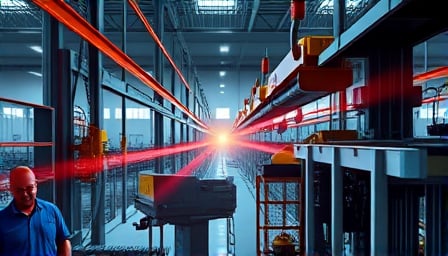Corporate Overview and Market Performance
Hensoldt AG, a German multinational specializing in precision sensors for protection, surveillance, and situational awareness, has demonstrated a robust upward trajectory in its share price. The company’s equity experienced a gain of more than 5 % on Monday, positioning it as a leading performer within the Rüstungstiteln sector. Technical analysis of intraday trading patterns indicates the absence of significant selling pressure, suggesting that the rally may sustain momentum in subsequent sessions.
Capital Investment Strategy
The firm is pursuing an aggressive capital expenditure program, earmarking approximately €1 billion over the next two fiscal years. This investment will primarily target the expansion of its high‑volume manufacturing lines and the integration of advanced automation and additive manufacturing technologies. Engineering teams are deploying modular production cells that leverage robotic manipulators, collaborative robots (cobots), and real‑time process analytics to increase throughput while maintaining stringent quality control—essential for aerospace and defense-grade components.
Projected revenue trajectories suggest that Hensoldt could approach a three‑fold increase by 2030, contingent upon the successful execution of its expansion roadmap. This growth forecast aligns with the broader defense procurement trends in Europe, where governments are augmenting spend in radar, optronics, electronic warfare, and space‑borne sensor systems.
Supply Chain and Production Efficiency
The expansion will be supported by a restructured supply chain that emphasizes resilience and just‑in‑time inventory practices. Hensoldt has entered strategic partnerships with Tier‑1 suppliers of high‑purity silicon wafers, laser diodes, and precision machining services. The adoption of predictive maintenance algorithms—trained on sensor‑derived data—will reduce unscheduled downtime by an estimated 12 %, thereby boosting overall equipment effectiveness (OEE) metrics.
In addition, the company is piloting a digital twin framework to model its production lines. This virtual replication facilitates scenario planning for capacity scaling, allowing planners to simulate the impact of component lead‑time fluctuations and to optimize layout configurations before physical deployment. Such data‑driven approaches are expected to reduce cycle times by up to 18 % and to lower unit manufacturing costs through tighter process control.
Technological Innovation in Heavy Industry
Hensoldt’s product portfolio is grounded in cutting‑edge sensor technologies that integrate radar, lidar, and electro‑optic systems into unified platforms. The company’s next‑generation space‑radar modules feature phased‑array antennas fabricated using gallium nitride (GaN) transistors, enabling higher power density and reduced heat dissipation. The incorporation of machine‑learning–enabled signal processing allows for real‑time target classification, which is critical for electronic warfare and surveillance missions.
Furthermore, the firm’s optronics division is advancing in‑vehicle night‑vision attachments that incorporate low‑light image intensifiers and thermal cameras. These devices are built on miniature, low‑power integrated circuits that meet the stringent size, weight, and power (SWaP) constraints of modern combat aircraft. The development of these systems is supported by a robust research pipeline that leverages partnerships with national laboratories and defense contractors.
Economic Drivers and Capital Expenditure Trends
The Bundesregierung’s commitment to increasing defense expenditure—particularly in the domain of space‑based systems—creates a favorable macroeconomic backdrop for Hensoldt. The projected €5‑10 billion in federal procurement contracts for the next decade underscores a sustained demand for advanced sensor solutions.
Capital expenditure trends in the defense manufacturing sector have shifted toward digitalization and automation, driven by the need to maintain technological superiority while controlling costs. Hensoldt’s investment in automation infrastructure, coupled with its focus on additive manufacturing for complex components, aligns with this trend. The company’s ability to rapidly iterate design cycles—thanks to digital twin technologies—provides a competitive edge in meeting evolving operational requirements.
Regulatory Landscape and Infrastructure Spending
European and German regulatory frameworks are increasingly emphasizing cybersecurity, data protection, and supply‑chain transparency for defense contractors. Hensoldt has already integrated secure enclave processing units and end‑to‑end encryption into its sensor systems, ensuring compliance with the upcoming European Union Cyber Resilience Act. Moreover, the firm has secured certifications under ISO/IEC 27001 and ISO/IEC 15408, bolstering its credibility with defense buyers.
Infrastructure spending—particularly in the construction of new production facilities and the upgrading of existing sites—has been earmarked by the Bundesregierung as a key component of its defense modernization agenda. Hensoldt’s planned facilities, slated for completion by 2026, will feature state‑of‑the‑art cleanroom environments and advanced vibration isolation platforms, essential for the precision assembly of optical sensors.
Market Implications
The convergence of increased defense spending, technological innovation, and efficient manufacturing practices positions Hensoldt favorably in the global defense supply chain. Its focus on high‑margin, high‑technology sensor systems allows the company to capture premium pricing, while its investments in automation and digital twins enhance operational agility.
Investors should note that the company’s valuation has already absorbed expectations of future growth, as evidenced by its recent stock rally. However, continued monitoring of regulatory developments—especially those pertaining to export controls and cybersecurity mandates—will be critical in assessing long‑term risk profiles.
In conclusion, Hensoldt’s strategic alignment with capital-intensive manufacturing, advanced sensor technology, and robust supply‑chain optimization underscores a trajectory that is both economically sound and technically forward‑looking. The firm’s expansion plans, backed by significant federal investment, are poised to elevate its market position and deliver substantial returns to stakeholders over the coming decade.
